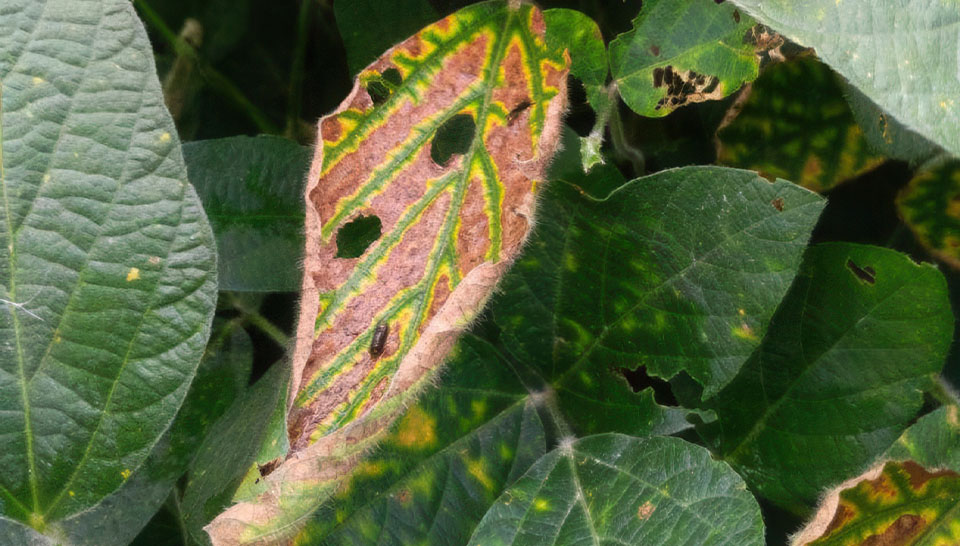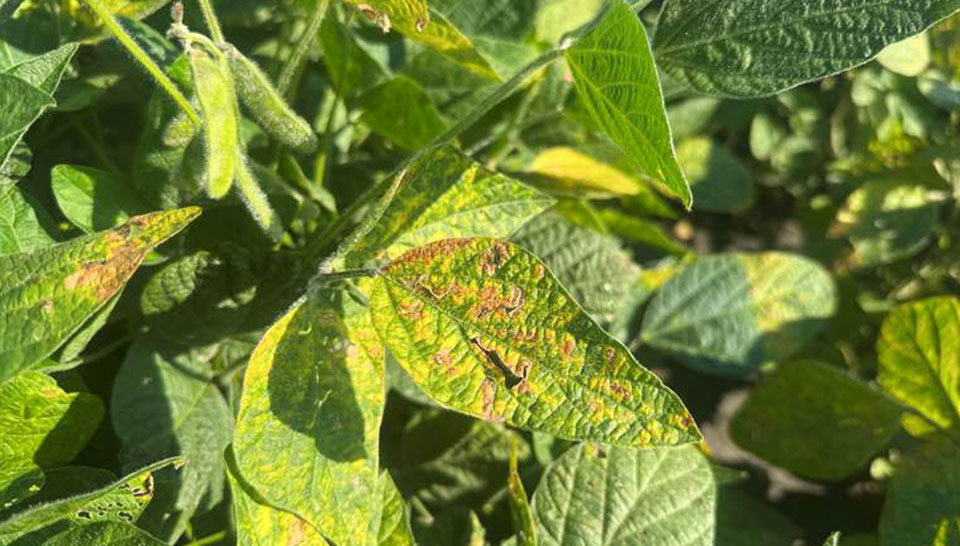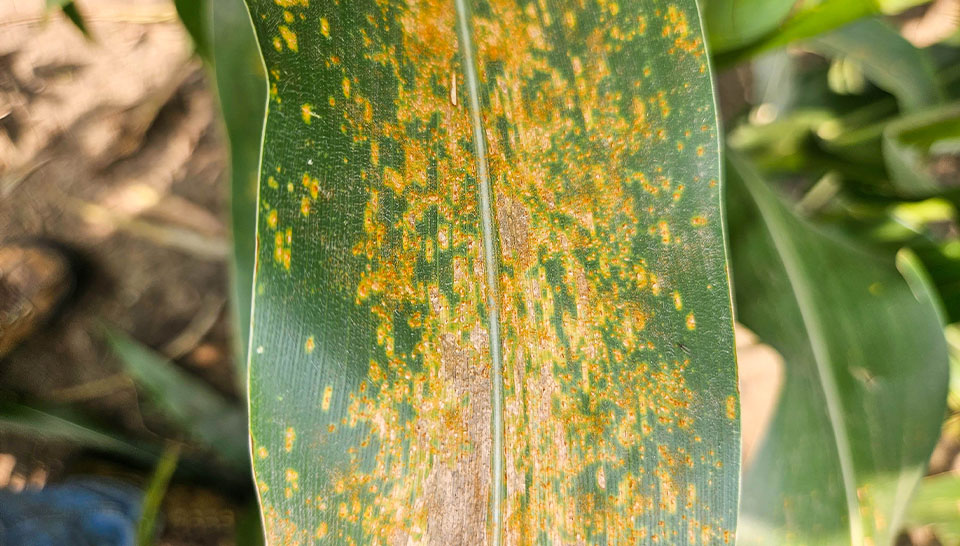
Sudden death syndrome in soybeans (Photo: Iowa Soybean Association / Brandon Iddings)
Walking Rows: Southern rust and SDS pressures
August 14, 2025
Iowa Soybean Association research agronomists report mostly in soybeans in R5 and corn R3–R5 stages and, with generally substantial yield progress. Key issues include southern corn rust, nitrogen deficiencies in corn, and sudden death syndrome (SDS) in soybeans. Agronomists advise monitoring fields, noting disease pressure for future planning, and preparing for harvest and cover crop planting.
Alex Schaffer - Central/South Central Iowa
As we move through the dog days of summer, the corn and soybean crops continue to mature. Soybeans are in the R5 growth stage, filling pods and making yield. Corn is in the R4 growth stage, but I have heard reports of some fields beginning to dent. Most of the farmers I have been speaking with are completing early yield estimates and are happy with what they are seeing.
The main issue I have seen in soybeans over the past couple of weeks is SDS. This is not surprising as SDS infects the soybean plant at the seedling stage under cool and wet conditions, which we had shortly after planting.

Symptoms of the pathogen typically do not appear until the R3 growth stage. The disease causes yield loss from early defoliation and a shortened pod-filling period of the soybean plants' lifecycle. There is nothing to be done about the disease now except to take note of where you have pressure and, therefore, likely a high amount of inoculum. My recommendation would then be to select a resistant variety and treat your soybean seed with Ilevo or Saltro when soybeans are planted in that field again.
The main concerns I'm hearing about from the cornfield are nitrogen firing, southern corn rust and poor pollination from wrapped tassels at flowering time.
Given the rainy growing season we've had, it would be nearly impossible to predict the amount of nitrogen a farmer would need to apply, not to see a deficiency, simply because we have lost so much during the growing season. My best advice would be to note any deficiencies and the rate you applied this year, and consider redistributing that fertilizer closer to when the plant needs it. There is little to do about southern rust at this time unless you have late-planted corn that isn't beyond R3 yet, and disease is only present in the lower canopy. Fungicide applications are not curative for this disease. If it has already taken over the field, there is no point in applying fungicide.
Shane Beck – Northeast/Northern Iowa
I have fielded calls regarding a few diseases in recent weeks.
For soybeans, I have heard a lot about and seen SDS across the countryside. This disease will likely continue to progress throughout the field, with the pockets continuing to grow by the week. With this disease, there is no cure at this stage. The infection takes place early in the growing season.

Sudden death syndrome
The best defense for this would be a good seed treatment like Ilevo or Saltro and to pair that with a variety that rates well against SDS. Besides the SDS, I have seen little other disease or insect pressure. The fields that I have been scouting have been clean, regardless of whether they were sprayed with a fungicide and insecticide.

In my discussions with a few farmers, the main disease affecting corn has been southern corn rust. This is a disease where the wind transports the spores out of the south throughout the summer. Usually, we will first notice this on the edges of fields and slowly make its way deeper into the field as the summer progresses. Certain hybrids are more susceptible to this disease than others, so some fields are showing a lot more pressure than others. Since we are approaching the R4-R5 stage in corn, there really isn’t anything economical to do about the disease.
Mikaela Connelly - Southwest/West Central Iowa
The humidity and moisture have continued into August, with both district 4 and 7 receiving some rain over the last week or so. Soybeans are in the early stages of R5 with little seeds developing in the pods. In these areas, I would say most corn is in the R4 stage now with some starting to approach the R5 stage (dent).
I would encourage those scouting their fields to note what diseases you're seeing in your hybrids and varieties, as this can be a learning curve for the next growing season on selection. Good notetaking about general observations from the spring to now can highlight management practices to adjust for the next growing season. For example, you can correlate a seed treatment to plant susceptibility of early-season diseases to now with hybrids and varieties that have different susceptibility to mid-to-late season diseases.

Corn has been getting hit hard with diseases this year, but I have seen little for soybean diseases yet. I would continue to monitor your fields as diseases can show up quickly.
As we wrap up August, prepare for harvest season by doing some equipment maintenance and ensuring everything works properly.
If you are considering having cover crops flown in by an airplane or drone, it would be a good idea to get those applications scheduled. I would attempt to seed the cover crop ahead of a rain to ensure good germination and growth.
When thinking of a cover crop mix, I would consider what your goal is with the cover crop (grazing, soil erosion control, etc). ISA’s Cover Crop Economic Simulator or Precision Sustainable Agriculture’s Cover Crop Selector are great interactive tools that can help with what species makes sense for your operation.
Craig Woods – Northwest Iowa
In northwest Iowa, everything is progressing nicely, despite continued ponding of low and poorly draining areas. Soybeans are well into the seed-filling period and are likely looking forward to taking advantage of ample soil moisture and forecast clear skies, while most corn in district 1 is around the R3 to R4 stage.

Due to many warm, humid days, southern corn rust reports have increased across Iowa, including northwest Iowa. For those who have already applied fungicide, they are unlikely to need to apply a second round just to manage southern corn rust. The effectiveness of fungicide treatments will depend on crop stage and disease severity, which will determine the return on investment.

Southern corn rust
SDS in soybeans has also shown up in northwest Iowa. While little can be done about it now, it can still be an opportunity to determine changes that could be made to assist in management for upcoming seasons. Some options include SDS-resistant varieties, seed treatments and managing soil compaction.
Lucas De Bruin - Southeast/Eastern Iowa
Fall is around the corner and conditions are causing some stress spots to pop up in fields.
I have seen a lot of SDS show up in the last week, however, overall fields are still pretty clean from a disease-perspective – despite the extremely conducive weather and year we have had for diseases. I think some of the hot nights we had in July helped slow progress for diseases.
I have been in a lot of tall soybeans this year. Although it is a good-looking soybean, it also has me concerned. One good storm and 5-foot-tall soybeans become 1 foot tall and 4 feet of headaches. Let's hope that doesn't happen.

With the tall soybeans, I have also noticed how far apart the nodes are – not stacking nodes like I would prefer to see. As long as all the pods fill out, it'll be alright.
The corn in districts 6 and 9 is denting, and the milk line is starting to move down. I have seen a few spots in cornfields start to fire. Overall, I have been happy with how the corn looks given the amount of rain we have had. This has helped move nutrients, including nitrogen.
I've been hearing more comments than normal about southern corn rust this year. A fungicide application seems to reduce the pressure.
Gathered by Kriss Nelson.
Back